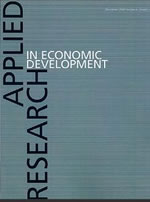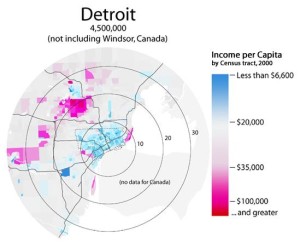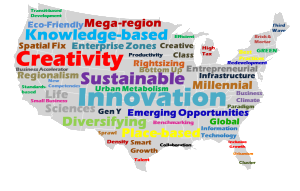Has State and Local Economic Development Lost its Ability to Innovate? Can We Practice what We Preach?
By The Economic Development Curmudgeon
We are at a pivotal point in our history that compels a thoughtful assessment of centerpiece ED strategies (innovation in particular) and recognition and reevaluation of America as an actor in global politics and soon-to-be second-largest economy. The post-WWII age has exhausted itself. Its transition into a new world era has major implications for how we conduct state and local economic development.
As we have done in the past (several times), an extended debate/discussion needs to happen so we can talk through, reason together in order to develop new, resuscitate old ED strategies and programs–as well as close the huge gaps between (1) mainstream ED and community development and (2) the academic/think tank–Practitioner Worlds.
In this discussion, it is difficult to impossible to justify not including an understanding of how American state and local ED evolved, and how it came to be what it is today. The Journal of Applied Research in Economic Development, accordingly is expanding its mission to include a two-year commitment to provide a FREE online introductory course on the history of American State and Local ED.
Critical Times Require Critical Re-Thinking
My recent history of American S&L ED (As Two Ships) posits our two-hundred plus year history is subdivided into four distinctive “eras”. We have worked in the Contemporary Era since 2000. It has been a troubled Era. Several critically important Contemporary Era strategies were formulated during Transition Era (1975-2000), perhaps the most disruptive Era in our history. Deindustrialization, regional change, suburbanization, collapse of the auto industry, free trade, the rise –and stagnation–of Japan, fall of the Soviet Union. are just some of the lovely dynamics that shaped Transition Era ruminations.
Transition Era strategies/dynamics include clusters, metropolitanization, sunrise industries, technology replacing manufacturing, Schumpeter-based innovation and entrepreneurship, and knowledge-based ED. One may fear these strategies fight the last wars. New dynamics and and page-turning events make us wonder if these strategies have lost their cutting-edge and are proving less relevant in our clouded Contemporary Era world. I fear some strategies have been overplayed, and that the fast-moving an turbulent Contemporary Era (think Great Recession-President Trump) has reshuffled America’s S&L ED deck of cards. Business as usual is no longer helpful. Retooling may be in order.
In the sections below I discuss two prominent ED strategies (innovation and knowledge-based ED) and two underlying, and less appreciated dynamics (metropolitanization and the federal government’s shift from New-Deal to Great Society intrusion into S&L ED to domestic retrenchment/ED devolution to states AND the effect of Cold War/post-Cold War global economic policy on S&L ED). These strategies and dynamics have interacted, and unconsciously “jelled”, blended, and blurred, to create a pervasive background, a Paradigm, that has shaped our reaction to the Contemporary Era turbulence.
I do NOT argue the Paradigm, or its elements, are “wrong”; they are popular and used by nearly every state and city. I think they are overused and so pervasive their potential effectiveness is diminished–and worse–as a background prism they have impeded our willingness and capacity to understand the brave new world that is emerging, and restrict, trivialize and distort other strategies from being considered.
This metaphoric Paradigm cries out for reevaluation and outright rethinking. I honestly fear it may be collapsing under its own weight much like urban renewal did decades ago. This issue is devoted to making the case that Practitioners in particular need to step back, observe with as few blinders and prisms as possible, the current state of affairs. Instead of doubling-down on our Paradigmatic consensus we need to question it and seriously consider whether other strategies are called for.
To help this reassessment and help those who wish to participate in it, the Journal is creating a new focus by bifurcating its mission to include not only bridging the gap between academics- think tanks (Policy World) and the on-the-street Practitioners, but by making available, free and open to all, in mid-March, summaries drawn from my two-hundred year history/on-going research. The object is to provide a historical context that allows us to make better sense of current events.
The final section will formally announce, i.e. “pitch”, the March grand opening for the new and improved Journal of Applied Research in Economic Development.
Impact of Metropolitanization, Changing Nature of Federal S&L ED Involvement, and Innovation and Knowledge-Based ED Strategies:
THE PARADIGM
The Paradigm consists of four related, yet distinct S&L ED strategies or ED-relevant dynamics that have braided into each other to form a cohesive strand. Developed during the Transition Era s two-decade long “Great Reindustrialization Debate”, the strategies this Paradigm incorporated realities of global competition, comparative advantage of nations/regions, the end of the Cold War, and American regional/metropolitan change–and others–into new strategies which, with modifications, have been carried forward into our Contemporary Era.
Within the Policy World the Paradigm enjoys almost complete acceptance, to the point it is regarded as simple, self-evident “truth”. Innovation, for example, ALWAYS, whatever the time period or sector/ industry, creates more jobs than it destroys is one such “fact”. There are many other such “facts” around which our current Policy World accept without question. I want to briefly consider several issues and concerns that becloud each element to support my position that the Paradigm is beginning to hurt us more than it helps us as S&L economic developers.
Metropolitanism: During the Transition Era our professional focus shifted from large central cities and their disruptive suburbs to metropolitan areas. Instead of fighting wealthy sprawling suburbs, major central cities were aggregated into one metro area. In time the basic unit of planning/analysis for the Paradigm became the metropolitan statistical area (MSA). From the perspective of my history that was a huge break from a two-hundred year jurisdictional and state-anchored policy context.
MSA has no roots that extend into the multiple jurisdictional ED-relevant policy systems and local economic bases. It relies on statistical indicators to measure its trends–and compares them to various national benchmarks. How well these indicators relate to specific programs and strategies is anyone’s guess. Measurement/ranking of metro areas benchmarked to national averages, sector/industry shares, or demographic medians prompted and facilitated a tilt toward a national reference point for evaluation and analysis, rather than attention to local policy systems and their concerns, priorities, culture, politics and dynamics which fell by the wayside. In its place a million or more useless and distorted “rankings” used only by self-serving business developers, ideologues, academics/think tanks, and media.
MSAs have become convenient receptacles for calling attention to national hot topics and justifying a one-size-fits-all ED strategy-solution. Given the sustained growth of innovation-laden geographies, MSAs have served our Paradigm well. Metropolitanism’s net effect has been American ED substituted data, databases, and data analysis for politics– and demographic statistical correlations and nation-wide solutions for nation-wide problems for political, partisan and policy-making processes. Economics and economic methodologies now dominate; urban politics and sociology imploded.
Fueled by any number of factors, cities and states copied, adopted and installed the elements of the Paradigm–but superimposed them on the vastly more important political initiatives and regional/ ideological rivalries characteristic of their respective policy systems. During the Contemporary Era the herd-like diffusion/adoption of the Paradigm by S&L policy systems meant (1) nearly all states and localities were formally following the same strategies, sectors, and programs, and (2) political ideology and self-interest differentiated executive administrations and legislative agendas, and (3) except for the largest cities, urban politics and policy lost Policy World interest.
Instead Policy World urban analysis reflected larger ideological concerns like the anti-neoliberal “Two Cities”, and governors launched a horrific incentive war for their electoral impact. Red States competed successfully against Blue States and Blue States doubled down on Paradigm strategies. Metropolitanism meant activities/policy processes of literally thousands of jurisdictions were viewed as either obstacles or role models for highly charged, sometimes ideological, oftentimes repetitive Paradigmatic-based analysis.
Practitioners, caught in the crosshairs of Policy World, Paradigm, and Polarization, kept their head down and stuck to their Paradigmatic knitting and politician’s agendas. states. That the Paradigm was enthusiastically embraced by Blue States, and only rhetorically adopted by Red States–the latter mostly in growth mode and the former less so–has meant the Paradigm exerted a disproportionate (and negative) impact on Blue States. The drift of our “legacy cities” and rust belt, the startling reality that 75% of 1970 distressed neighborhoods remain distressed today,and the crisis of rural areas owes much to their falling into the cracks of the MSA-focused Paradigm’s one-size-fits-all statistically-determined S&L ED policies and politicization of ED.
Paradigm-heavy state and local ED policy systems often witnessed an extremely political surge of neighborhood-based actors and political leaders. While formally laboring with innovation and the like, the policy system’s hottest topics fell outside the Paradigm’s priorities; homelessness, affordable housing, gentrification, commercial (mall) redevelopment, gangs, and drug addition were unable to gain traction and lacking any clear solution served to further paralyze/polarize local policy-making.
Shifting Federal S&L ED Dynamics: The federal government has always been involved in S&L ED–and will always be involved in the future. The intensity and content of that involvement, however, has been quite varied. From FDR to LBJ the federal government deeply involved itself in domestic–hence state and local–economic development. Richard Nixon (1968) was the turning point in what As Two Ships calls the Thermidor of federal intrusion into S&L ED.
Since then the feds have been pulling back in terms of funding and leading with its own domestic policy agenda. They now seldom lead or push states and local governments into new federal programs/strategies. President Obama’s HUD initiatives for example did not take root and drew huge pushback from locals. The federal government during the Transition and Contemporary Eras shifted from a domestic S&L ED policy/strategy agenda, instead by responding to a new global politics, and the rise of environmentalism/climate control they generated a new set of profound intrusions into S&L ED.
The Cold War and its conclusion in the collapse of the Soviet Union witnessed movement from its long-standing “protectionist”, America First, economic foreign agenda toward facilitating its new role as leader of the “World” and the U.S. as its leading economy. In post-WWII global economy, the USA became the globe’s reserve currency, and chief fundor of a network of global organizations/treaties/trading blocs. American firms became global behemoths. Global trade evolved into “free trade” which rested somewhat delicately on competing comparative advantages and national foreign policy interests. Little noticed in all this is the battleground, or resting place, for all the transformations created by free trade, positive and negative, were our state and local economic bases. FDI became a new target for attraction and foreign–or American firms closed down shops and factories after mergers. Small wonder a host of S&L global/export (even redevelopment) strategies developed in reaction.
Beyond state and local influence were the chief beneficiaries of global free trade, the neo-liberal corporate global behemoths. Now we are treated to steel mills in Mobile, car plants in South Carolina, and Amazon’s humiliating “offer” of a second headquarters, exposing still further how global concentration, sector oligopoly, and S&L weakness has created an entirely new world than that known in 1999. And what does the Paradigm have to say about this?
Transition Era globalism tolerated high levels of cross-border population mobility, which, through the prism of the Paradigm was looked upon as a cheap, often creative–innovative workforce (who worked disproportionately for global corporate behemoths), a solution of sagging rates of entrepreneurial starts up, and agents of disruptive innovation. The freer and unrestricted was trade and immigration, the better off we were. Growth was axiomatic. But when immigration transcended into morality, identity politics, and populist reaction, the debate changed–but the Paradigm did not.
The Paradigm responded it had the necessary tools to deal with immigration impacts: immigrant entrepreneurs, EB-5, FDI, H1B, startups/vc, internal relocation to good jobs, all sorts of K-12 education reforms/programs/facilities, ESL, skills retraining/STEM, cluster development, targeted sunrise sectors, community colleges, and university-driven ED complete with accelerators, certifications, and metropolitan-level regional plans. “No Problems Man”. Times Change, however. State politics, in places like Arizona, Texas and California were dramatically reshaped. Immigration in its various forms became the primary issue of state politics. Entire geographies, like Orange County–California itself–were demographically turned upside down. But the Paradigm persisted.
The Contemporary Era witnessed increased numbers of wartime/disaster refugees. Religious-driven civil wars in the Middle East, Africa, and even Southeast Asia mobilized huge numbers of refugees, in spasms, from countries new to the developed world; countries with different cultures/religions not easily reconciled with developed nation cultures and economies. Refugees carried with them, willingly or not, civil war loyalties, making their new homeland a potential battlefield. This was not your grandfather’s Transition Era cheap, entrepreneurial and innovative workforce immigration context.
Then environmentalism and climate control entered the global picture and we had a new set of sunrise ED targets–and obsolete sunset industries (think coal/fossil fuels vs. lithium batteries, electric cars), and a host of national regulations that penetrated deep into S&L ED. EPA became a major force in S&L ED. The reaction by S&L was always complex and diverse. Consider the western state Sagebrush Rebellion, and now sanctuary cities. Consider California’s leadership in climate change-related ED initiatives. Caught up in the swirl of creativity, innovation, and brave new technologies, the Paradigm now attempts to bridge the chasm once again between a new round of sunset and sunrise industries–and all that implies.
Environmental regulations, NEPA, and EPA in particular have become major players in state and local development and redevelopment. Infrastructure, traditionally the federal government’s most used and most effective S&L ED strategy, has lost its ability to provide short-intermediate term impact. Shovel-ready means seven to ten years before cutting the ribbon. Pipelines anywhere near an Indian tribe have circled their construction vehicles each night. Stimulus programs flow to planners, consultants, and universities–not to construction companies. Trump’s cornerstone infrastructure initiative is to reduce this regulatory intrusion-in Blue Paradigm States it will be resisted, yet, seized upon wholeheartedly by Red States. Guess who is caught in the crosshairs?
Innovation and Knowledge-Based ED: The rock star of the Paradigm was always innovation and its prerequisites: creativity, entrepreneurism, startups and knowledge-based ED. Certainly innovation was applied to manufacturing (excuse me, “advanced manufacturing”), but the various forms of technology (info, hardware, software, bio-life sciences, alternative energy) had replaced manufacturing as S&L’s prime and cornerstone industry. Innovation is linked at the hip to knowledge-based ED and entrepreneurism. This has meant, despite their distinctly different programs. constituencies, and sub-strategies, both have become flip sides of the same rubik-cube strategy. Cities and states mixed and matched the various elements usually in alignment with policy entrepreneurs and politician agendas.
That both innovation and education played very nicely in the statistical, data-driven metropolitan sandbox, doing their best to ignore the rude interruptions caused by immigration disruptions in their local economic bases, neighborhoods and school systems (not to mention fiscal capacity). Applying the Paradigm often came at the expense of non-technology/manufacturing jurisdictional business retention. Not being a gazelle meant your firm was top-heavy with “bad” jobs and occupations. The retail and service sector, even many elements of healthcare sector did not easily fit into the Paradigm. Unless you needed wi-fi, tech startup financing, or wanted to use an accelerator, one/two person firms were largely ignored. The Paradigm has unevenly affected the various sectors and industries in our local economic bases.
On the other hand, while “education”, essential to innovation/creativity so the literature tell us, did not prove very open to ED involvement. Not that it mattered. The chaotic politics/financing/effectiveness of local schools beclouded the application of any knowledge-based strategy. To make matters worse, statistical correlations of high school/college graduation rates and innovation indicators are high, we are no longer sure if knowledge itself is being transferred to students. An entirely different set of statistics, largely outside the Paradigm’s interest, suggest otherwise. That a degree increases earning power is likely true–but how it interacts with innovation and its associated strategies is unclear, but the link itself has become a truism not to be attacked.
The Silicon Valley and the pockets of innovation scattered throughout the nation capture Policy World and media attention. Growth and prosperity that accompany these geographies is real–but if San Jose is any indication, neither have solved a goodly number of social-economic problems that plague San Jose and much of the Valley. That growth/prosperity/high educational levels and innovation can hide, certainly coexist with a submerged emerging two class society and economy is only a very recent concern.
If everybody is chasing innovation and its gazelles, is that a problem in and of itself? Do we flood emerging innovative sectors with “facilitative atmospheres, financing, accelerators, mentoring so that the supply of innovation exceeds the capacity to adopt it. Has Paradigmatic ED lots of cutsey innovation with terrible business plans, and spoiled entrepreneurs. Scarily, innovation–and the Paradigm–has diffused across the developed world, and the emerging world as well. Even the French are trying to jump start their own Silicon Valley. In following innovation/knowledge-based ED the USA and its states and cities has no known advantage save its head start–which also means it is maturer, self-satisfied, and increasingly dominated by Big Behemoth technology firms. Every American city of any size competes to develop or attract the same firms, sectors, industries, occupations, and an educated workforce (Read the Geography of Jobs).
That means Buffalo NY innovation competes with that of Beijing; the Silicon Valley faces new rivals like a projected French Silicon Valley, Dubai, Ireland’s Silicon Docks, U.K.’s M4 Corridor, and assorted Chinese cities and provinces. Venture capital, in amazingly ample quantities, sloshes across national boundaries, as do IPOs, and foreign technology workers. The first monkeys were cloned by Chinese. How much innovation does the world demand at any one point of time? How effective is it when everybody promotes innovation?
Perhaps the most unanticipated Contemporary Era shift regarding innovation was in how we described its chief purpose, and how we thought of innovation. Innovation always was synonymous with “change”–and that was fine–but then it became inseparably linked to “disruptive change“. Innovation became valued because it “disrupted”–and disrupted always meant eventual growth, new job creation, and prosperity–a potential Amazon in the making. Not to worry–more jobs will always be created than destroyed, somewhere, sometime. That cannot be questioned. But ….
The urban physical deterioration that follows is a slow-motion train wreck, with malls/car dealerships adding to our urban inventory of shuttered factories. Unemployment has never been lower in the last decade. Get an education and you’ve got a job. That the Paradigm’s success could provide fodder for a populist rebellion was off S&L ED’s radar screen. It still is. The old bromides (relocation, skill retraining, and education) remain constant as the remedies–only more so. As for disruptive innovation–let’s have more and create still more inevitable jobs to get us out of this.
So, as we disrupt still more with artificial intelligence, drones, driverless cars, and the day-to-day application of technology to job processes (digitized cash registers replacing cashiers), a new spectre has darkened that unfailing growth strategy. Forgive me for saying, is it possible that steroidal disruptive change in a period of political instability sounds a lot like pouring oil on a fire.
As Robert Gordon has amply demonstrated, however, the Contemporary Era sunrise industries are not likely to be job generators that compare with manufacturing, communication, and lifestyle-changing innovations of the 19th century. Alexa is not air conditioning. Uber, founding father to the gig economy, is what we used to call the “second job”, but have renamed it to fit into the Paradigm. One-day delivery is “just-in-time” applied to retail. Solar panels are not electricity–they are simply another way to make it. BTW has anyone found a watch that measures “nanoseconds”?
A key issue concerning innovation and knowledge-based ED is what it leaves out–and what it can embrace. “Trump Forgotten People” was created by a variety of forces and dynamics, but the “hollowing” out of occupations and professions, even industries is nagging at our Paradigmatic-laden minds. Innovation embraced manufacturing. We call it advanced manufacturing now–with large dollops of robots, software, math, and export markets–but fewer jobs, lots fewer. But they are the “right kind of jobs”, great multipliers.
In part, innovation has yet to serve manufacturing well–at least as far as job creation and employment levels. Automation reduces the number of jobs albeit creating a smaller number of higher paid, sustainable jobs. What is needed is something like Steve Case’s Rise of the Rest that targets American Heartland “third-wave of technological change” that centers on startups that manufacture consumer-driven technology products with smaller markets that are unattractive to technology behemoths.
What innovation/knowledge-based didn’t embrace was service sector jobs–you know the ones that populate a predominately service-sector American economy. They are the “wrong”, dead-end, low-skill jobs, the ones that deal with people not ideas or information. For the Paradigm, these poor folk are the real “deplorables”–read Hillbilly Elegy.
Could it be that the Paradigm is a modern day version of social Darwinism, and the generator of a two-class American society?
Wrapping Up:
To reiterate my core message. The Paradigm is not wrong, per se. Rather its overwhelming success has hardened it into an inflexible and thoughtlessly applied strategy that, I fear, is not working as well as it ought, and to the extent it does create results, those results are proving harmful to society, if not to the economy. The assumptions associated with the Paradigm increasingly ring hollow. Fabricated twenty or more years ago in response to a host of problems and dynamics that damned near overwhelmed us, innovation has has not fared well since the 2008 Great Recession. It needs rethinking–so does metropolitanism. We need to close the huge gap between Practitioner ED and Policy World ED.
We have gone as far as our WWII victory could take us. We are now entering a new global order, even our reserve currency is threatened over the long-term, and the UN, World Bank, IMF, Doha and other major international organizations fabricated from that post-WWII Era are adrift, searching for financing, power and sometimes relevance. New international orders, trade blocs, treaty systems, and political alliances are emerging. The politics of oil is has turned upside down with American oil export. Africa, that hotbed of civil wars and dictatorships is increasingly being touted as the future factory of the world–even though it cannot feed itself nor care for its sick. Hmmm…they said that of China in the 1960’s–and India in the 1980’s. That is why I have titled my second volume as “the Twilight of American Growth“.
What I argue is not that American decline is inevitable, or even soon. Rather, it is clear that our State and Local ED was forged in a global and economic GROWTH context–and that period of unmitigated growth is now over. Decline is an option–it has been for seventy years or more. The task is for our former growth-biased strategies need to adjust to a less favorable global context, complex demographics, and that state and local solutions should be found at those levels–not from the national government although that level plays an important role.
We may have lost the keys to our past great success.
Think about your reaction when you lose your car keys. Instinctively, you reconstruct your past. Where were you? ? What did you do? When did you do it? What clothes were you wearing? What was happening? What could have gone wrong? What can you do so you don’t do it again?
That’s your personal history.
Basic instincts when faced with a problem or crisis is to understand your past and look for clues. That is a role history has played for 3000 years. History hasn’t lost relevance because of the Internet, algorithms, or Donald Trump. Just the opposite. At this most critical time, American economic development history is critical to opening our minds to what was, how we got to where we are, and what we could be. It makes us aware of timeless questions and concerns that constantly reappear wearing different clothes.
It is time to add to, refine, the Paradigm, not to end it. Open the Paradigm to new, or to older strategies tossed aside. Time to review and to begin serious experimentation in new strategies and programs. It may be necessary to rediscover older programs and strategies whose importance has risen yet again amid this time of troubles.
This is not the first time in our historical experience that we have exhausted a paradigm, and frankly, the history suggests that unless we get smarter fast, the transition from one paradigm to another can create crises, result in system transformation, and in general great distress and very uneven economic growth. History, seldom repeats itself literally, but the same problems constantly reappear at intervals, demanding a return to older strategies tossed aside by dominant paradigms.
This Journal can’t do it all, of course, but our new niche is expand our mission to link Policy and Practitioner Worlds by making available (FOR FREE) in brief readable modules the two-hundred year history of cities and states in American economic development. We are going to offer an online course, developed serially over the next two years, consisting of shorter, non-academic thematic modules which will added to every three months. This it is hoped will provide context and historical foundation to the Rethinking. In any case, it will provide to any economic and community developer, Policy World and political world professional a readable background to one of the most interesting professional history America can offer.
In March we will post two themes with about fifteen modules. They will take us through, in an introductory fashion, the 19th century. Next month more information/table of contents will be provided.
Peace,

“Bob Dylan – The Times They Are a-Changin'” by Source. Licensed under Fair use via Wikipedia – http://en.wikipedia.org/wiki/File:Bob_Dylan_-_The_Times_They_Are_a-Changin%27.jpg#mediaviewer/File:Bob_Dylan_-_The_Times_They_Are_a-Changin%27.jpg













Comments
No comments yet. You should be kind and add one!
The comments are closed.